The long-standing Toyota and the recently revitalized Kia, with distinct approaches to their top-of-the-line family haulers, come to a head in this comparison. The 2024 Kia EV9 GT-Line is an all-electric vehicle, whereas the 2024 Toyota Grand Highlander Max Limited is a powerful hybrid. The Kia SUV has futuristic aesthetics, whereas the Toyota SUV has traditional looks that would fit better in a sci-fi video game.
Given these stark contrasts, this comparison serves as a two-way evaluation of the products as well as a collision of car-building ideas. Continue reading to find out which vehicle offers the greatest approach to the tried-and-true three-row segment: the Grand Highlander or the EV9.
Performance
The most powerful drivetrain for the three-row SUV is used in the Grand Highlander Max for 2024. To produce a combined 362 hp and 400 lb-ft of torque, a 2.4-liter turbocharged four-cylinder engine works with two electric motors, one in the front and one in the back.
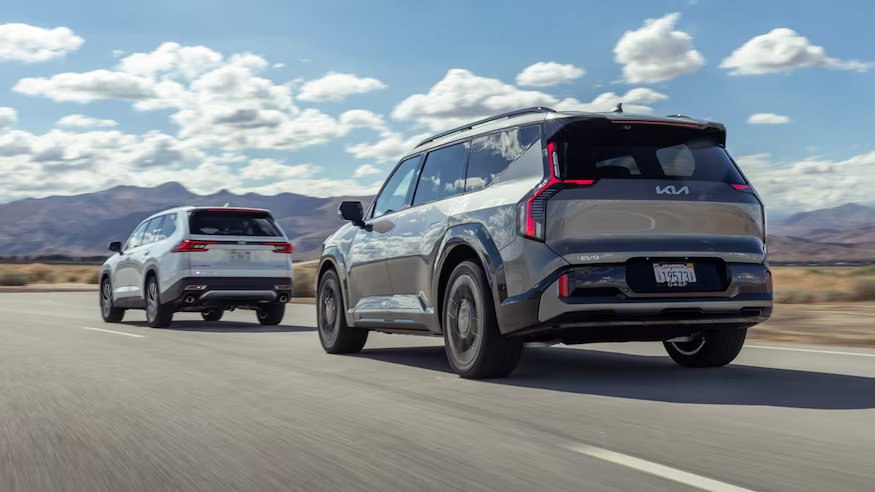
A six-speed automatic transmission controls shifting, and all-wheel drive is standard. The 0-60 mph time at the track is only 5.9 seconds, demonstrating the quick acceleration.
The Grand Highlander would easily defeat a more traditional SUV that ran on gasoline if they were pitted against each other. The hybrid drivetrain has a lot of low-end torque and pulling power at freeway speeds, and it is robust and quick. The turbocharged engine and the Grand Highlander’s six-speed automatic transmission work well together to deliver seamless and accurate gear changes.

For a vehicle in this class, the Grand Highlander’s three-row SUV displays light steering with a good on-center feel when being tested on twisting roads. High-efficiency tires readily lose traction, but the majority of people won’t be caning their three-row Toyota through tight turns.
Unsteady road conditions cause the SUV to tremble visibly on sloping pavement. The Grand Highlander’s brakes deliver rapid bite, but they don’t inspire our confidence as much as we’d like during prolonged stops.
The 2024 Kia EV9, meanwhile, has two electric motors to provide a combined 379 horsepower and 516 lb-ft of torque. Although acceleration is still outstanding, as a GT-Line model, this EV9 has some performance left over for the next EV9 GT. In just 4.5 seconds, the EV9 can accelerate from 0 to 60 miles per hour, and it voluntarily goes faster with smooth linearity.
The EV9 handles well enough on a road course despite not being a fully developed performance model. It is surprisingly enjoyable to loop on a winding road thanks to direct steering, upright body poise, and controlled braking. You can sustain momentum through a curve and accelerate out of it with an entire 516 lb-ft of torque thanks to the low center of gravity.
Although the EV9 seems quick off the gate thanks to its pace, its bulk and soft suspension settings can cause the large Kia to feel wallow on a curve. On the other hand, it handles rough surfaces with the confidence and distance of a high-end vehicle.
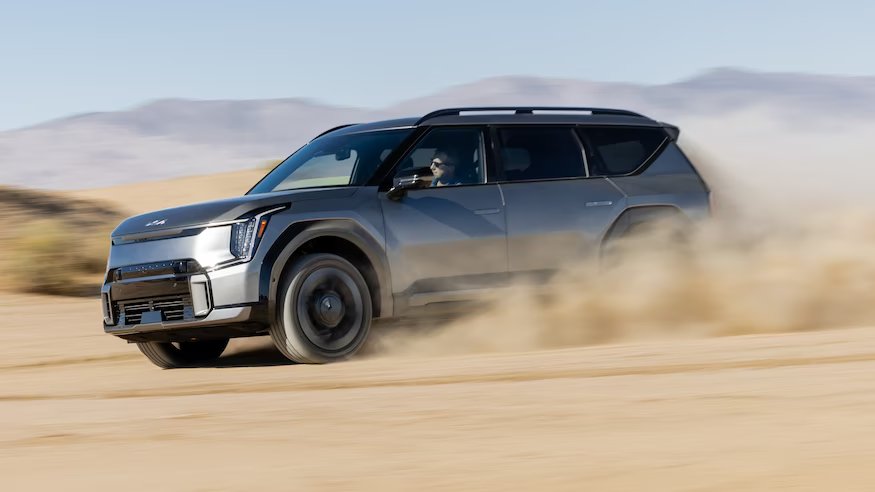
The EV9 supports variable levels of regenerative braking, like many other EVs. Full one-pedal driving is possible when the transmission is turned all the way up to the I-Pedal mode, which we have found to be the most enjoyable way to drive the large Kia.
It is just as easy to control speed while cruising down the highway and to bring the three-row SUV to a smooth stop at an intersection as it is to depress the brake pedal.
The huge SUV from Kia accelerates rapidly while charging as well. It can quickly top off its 99.8 kWh battery thanks to its 800-volt architecture, which supports fast charging at rates up to 230 kW. According to Kia, the EV9 can recharge from 10 to 80 percent in just 25 minutes.
A dual-motor vehicle like this one claims to have a total range of 243 miles, and throughout our testing, we found the EV9 to be economical with power use. The three-row SUV from Kia is not only faster than its competitors, but it also boasts convenient charging features.
Interior
The Grand Highlander’s interior is among the best in the Toyota lineup as a result of an intriguing material combination and a generous amount of soft surfaces. The front row has satin gold accents because this model employs the Max powertrain. The HVAC knobs have a smooth, rubbery feel, digital temperature readouts in the center of the dials, and are similar to a more upscale version of those found in the Toyota RAV4.
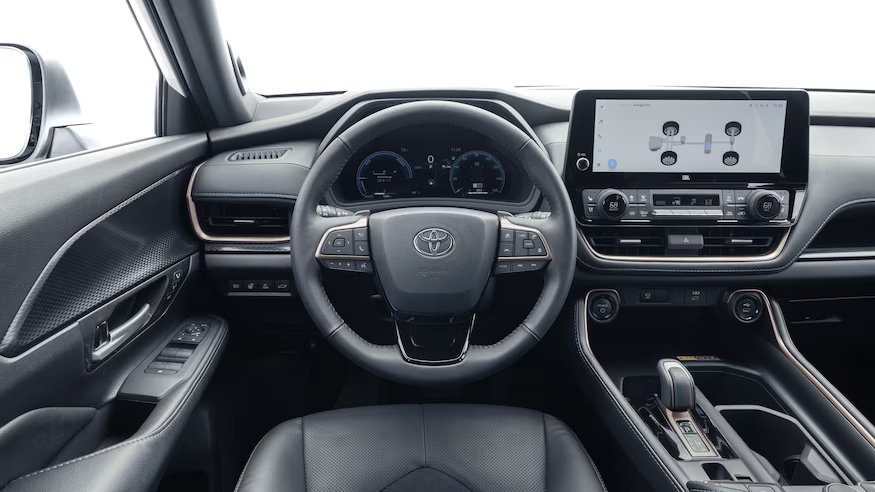
There are three USB-C ports up front, one of which is located on the dashboard next to the smart storage shelf and is specifically for the passenger. The well-bolstered, plush, and supportive ventilated chairs provide excellent support.
Two substantial displays, including a 12.3-inch completely digital instrument cluster and a 12.3-inch infotainment touchscreen, make up Toyota’s capable technology suite. Both devices include responsive visuals and readable typefaces.
The JBL 11-speaker audio system should be adequate for most drivers, but Kia gives the EV9 a superior 14-speaker Meridian system that outperforms the competition.
As long as the lane markings are plainly painted, Toyota’s driver assistance technologies do a good job of keeping the car in its lane, especially on narrow or unusual routes. We love that the 360-degree camera system’s clear images are displayed in parking lots, making it simple to position the rather large Grand Highlander in confined spaces.
The readout also features a stylish 3-D image that depicts the vehicle from the outside.
There is sufficient room for an adult to sit behind another adult in the driver’s seat in the second row. With plenty of legroom and access to two cupholders located in a detachable caddy that anchors between the captain’s chairs, passengers will also be comfortable.
Second-row passengers may charge their gadgets on longer excursions using two USB-C connections in the back as well as a built-in AC 120 V 1500 W outlet. Although Toyota provides these seats with a ton of functions, the actual chairs are flat and lack significant bolstering.

The front row of the EV9 has a fantastic range of materials. It uses more soft materials than the Grand Highlander does, and the leather is incredibly supple. The EV9 has more of a sporty feel thanks to well-spaced, metal-covered pedals.
The EV9’s cabin is further elevated to almost luxurious elegance by a soft micro-suede canopy. Similar to what Genesis offers in the top-tier G90, the passenger seat can even be controlled from the driving seat using toggles on the side of the chair. The front-row headrests, which have a silky mesh covering that is supportive but yet feels strong and luxurious, deserve special mention.
Additionally, we appreciated Kia’s packaging for the remainder of the interior. A large storage bucket, for instance, is located between the driver and passenger seats up front. A tray table that comes out from the center console is located in the comfortably outfitted second row.
The tray may be removed to reveal a sizable nook for even extra storage. The second-row seats in contrast to the Toyota, are both heated and ventilated. The EV9 will make purchasers feel as though they are getting their money’s worth in addition to massage chair features.
Conclusion
Even though Toyota and Kia used distinct development strategies when creating the Grand Highlander and EV9, our time with both vehicles revealed a clear winner. The EV9 GT-Line outperforms its competition in terms of equipment and driving poise and polish.
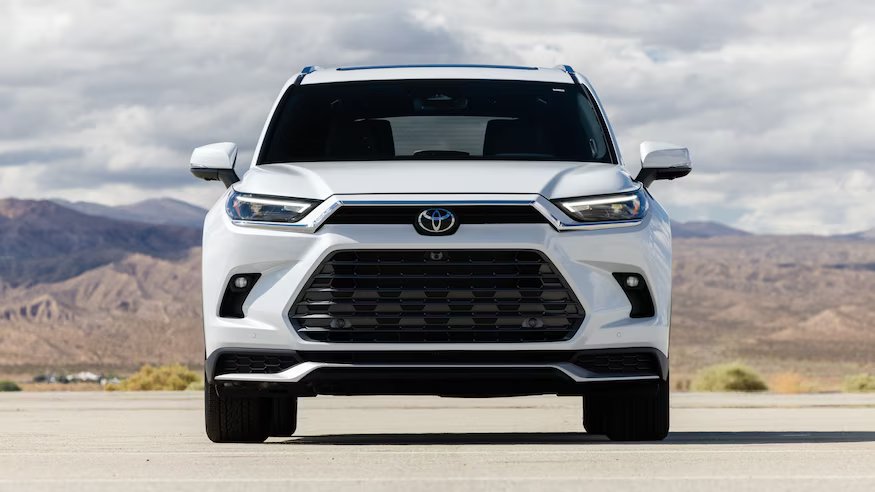
The only catch is the Grand Highlander probably has more affordable prices; the vehicle in our test had a sticker price of $57,810, while the entry-level model starts at $55,435. We anticipate Kia to price this 2024 EV GT-Line as configured at roughly $75,000. The all-electric SUV’s single-motor models should cost roughly $55,000.
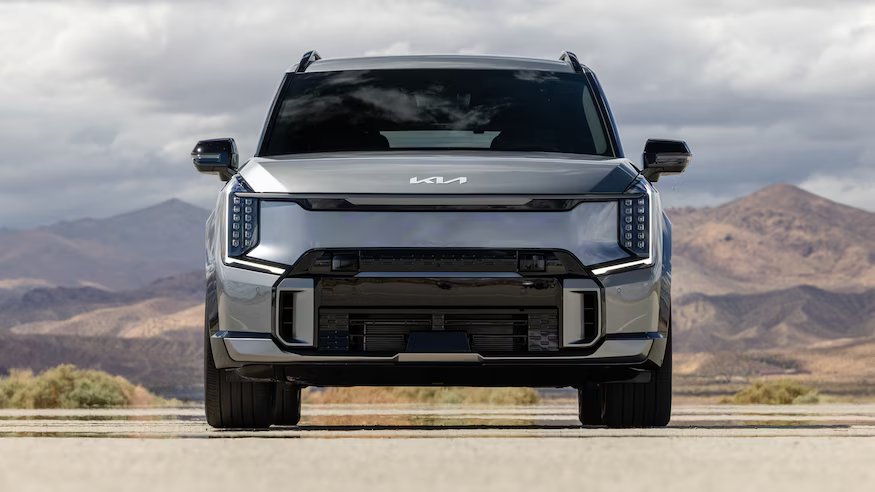
Even with this significant price difference, we believe the Kia EV9 is worth the extra money because of its better-thought-out packaging and industry-beating performance. Rival automakers will have to work hard to dethrone Kia from its newly established position as the industry leader in the three-row mainstream class, which has a completely electric challenger.

